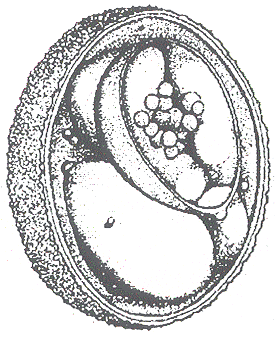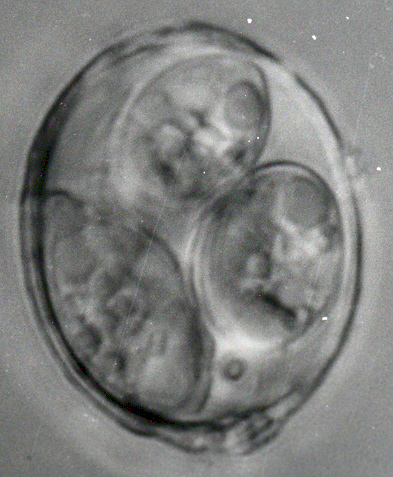Eimeria vagrantis Hertel and Duszynski, 1987
Type host: Sorex vagrans Baird, 1858, Vagrant shrew.
Other hosts: Sorex fumeus Miller, 1895, Smokey shrew; Sorex trowbridgii
Baird, 1858, Trowbridge shrew.
Type locality: NORTH AMERICA: USA, New Mexico, Otero County, 8.8 km NE Cloudcroft.
Geographic distribution: NORTH AMERICA: USA, Arizona, New Mexico, Oregon, Vermont, Washington.


Description of oocyst: Oocyst shape: ellipsoid;
number of walls: 2;
wall thickness: ~1.0;
wall characteristics: outer, golden yellow, rough, ~3/4 of total thickness;
L x W: 26.6 x 21.8 (24-32 x 20-35);
L/W ratio: 1.2 (1.1-1.5);
M: absent;
OR: absent (thought to be PGs?);
PG: 5-10 dispersed granules (named as PGs, but possibly an OR instead?).
Distinctive features of oocyst: relatviely large number of dispersed PGs.
Description of sporocysts and sporozoites:
Sporocyst shape: ovoid;
L x W: 15.9 x 9.0 (13-17 x 7-10);
L/W ratio: 1.8 (1.5-2.2);
SB: present;
SSB: present, ~2 times wider than SB;
PSB: absent;
SR: present;
SR characteristics: a cluster of 10-15 globules;
SP: with a distinct RB at one end.
Distinctive features of sporocyst: high L/W ratio and SSB 2 times wider than SB.
Prevalence: 5/112 (4%) S. vagrans; 1/16 (6%) S. fumeus;
1/105 (<1%) S. trowbridgii.
Sporulation: Exogenous. Oocysts sporulated in 7-10 days in 2.5% aqueous (w/v) potassium dichromate
solution at ~23 C.
Prepatent and patent periods: Unknown.
Site of infection: Unknown. Oocysts recovered from feces and intestinal contents.
Materials deposited: Skin, skull, skeleton and tissues of the symbiotype host
are preserved in the Mammal Division of the Museum of SW Biology, UNM: MSB No. 40945 (NK 1589, female),
D.J. Hafner #1671, 17 August 1979. Photosyntypes in the USNPC No. 86354.
Remarks: This species resembles Eimeria dissimilis Yakimoff and
Gousseff, 1935, from the Eurasian common shrew (S. araneus) and E. fumeus from the
smokey shrew (S. fumeus). It differs from E. dissimilis in oocyst L/W ratio (1.2 vs 1.5) and by
having a coarse, granular SR, SB and SSBs that E. dissimilis aparently lacks. It differs from
E. fumeus by lacking a PSB and by the size and shape of the SSB.
References: Hertel and Duszynksi (1987).



